Dominican ‘Tostones’, Haitian ‘Bannann Peze’ & DR’s Deportations of Haitians
Two identical fried plantain treats from one island divided by colorism and migration.
Bannann Peze, meaning “pressed banana” in Haitian Creole, is identical to Dominican fritos or tostones, plural for tostón, meaning “to toast” and the name for a Spanish coin during the colonial period. As the saying goes, the world might be a better place if we traded tostones instead of coins. These addictive fried snacks are shared throughout the Caribbean, from Jamaica to Puerto Rico, and even in Mexico, Venezuela, and Columbia, known as patacones. Regardless of the locale, they all begin with unripened green plantains, soaked in salted water or a vinegar bath, then twice fried to crispy perfection.
Despite sharing food, heritage, and the island for centuries—the harsh asymmetry between DR and Haiti couldn’t be more black and white.
My attraction and affinity to the people of Haiti and the Dominican Republic came early—like attending junior prom with Victor Muñoz, my first kiss with Charles Jean-Pierre, or the late nights at Dominican clubs where I was passed a plate of food as soon as I stepped off the dancefloor. There’s an undeniable magnetism about the island’s people: their bilingual charm, romantic (love-bombing) flair, and a stunning array of complexions and hair textures that reflect both allure and cultural richness. Yet, Despite sharing food, heritage, and the island for centuries—the harsh asymmetry between DR and Haiti couldn’t be more black and white.
Hispaniola, a divided Island that created DR and Haiti
To grasp the complexities of today’s Haiti and the DR relations, we should delve into the rotten roots of their separation and acknowledge the Indigenous Arawak Taíno people who thrived on the island of Ayiti the “land of high mountains” before it was either country. The Taíno culture’s deep connection to the land was tragically decimated by disease and enslavement when in 1492, your boy Christopher Columbus first settled in the Americas on the island of Ayiti renaming it Hispaniola.
Hispaniola was later colonized by Spain followed by France and was the center of the brutal plantation economy that relied heavily on involuntarily enslaved African labor to fill the void left by the Indigenous populations who had died (roughly 85% of the Taíno population died in the first 30 years of 16th the century). By 1697, Hispaniola was divided between Spain (Santo Domingo) and France (Saint-Domingue), setting the stage for a colonial battleground that would forever shape the identities of its inhabitants for centuries.
As many of us are now familiar, Haiti gained its independence in 1804 after a champion slave revolt, becoming the first-ever free Black republic in the world. Haiti’s declaration of independence sent shockwaves through slaveholding societies worldwide and as a result, the country has been met with hostility and debt-trap diplomacy ever since. The U.S. and European powers largely shunned Haiti, fearing the spread of revolutionary ideas. During that time, the Dominican Republic also endured a 22-year occupation by Haiti, which to some was characterized by heavy taxation and cultural shifts that turned many in the DR resentful.
Almost two decades priot the DR declared its own independence from Spain in 1821. And in contrast, when the Dominican Republic asserted its independence in 1844 from Haiti, it emphasized its European heritage that marginalized its Black population. After gaining independence, the tensions eventually simmered but by the 1920s, Haitian migrants were becoming integral to the Dominican industries, yet often faced exploitation and discrimination amidst stark economic disparities. Sentiments worsened when Rafael L. Trujillo came into power in 1930. He continuously highlighted the distinctions between Haitians and Dominicans in a vile way claiming them as inferior humans to those of Dominican descent which downplayed and omitted their deeply shared roots, culture, and bloodlines. Framed through a lens of European identity, many in DR until this day reject their African roots.
The Modern Divide
While the differentiation is rooted in politics, it also reflects cultural currents, as Dominican leaders have historically aligned themselves with European heritage, cultivating an identity that marginalized the Black population in and out of DR. This narrative and the ongoing fear of Haiti and its revolutionary legacy, framing Haitians as a threat to national identity and stability. The dynamic has persisted into our modern era of global Haitian sentiments, fueling discrimination and violence against those of Haitian descent in the Dominican Republic. It also mirrors the unrest and brutality witnessed at the U.S.-Mexico border, where both the United States and Mexico mistreat stateless Haitian peoples who—like any fleeing from rampant gang violence—deserve a place to migrate.
The 2013 ruling by the Dominican Constitutional Tribunal judgment arbitrarily stripped the nationality of roughly 245,000 Dominicans of Haitian descent born in the country. The judgment restricted the jus solis “right of soil” ruling to all children born to parents with irregular migratory status between 1929-2010 (stretching back for generations) and withdrew citizenship retroactively from Dominicans born to Haitian parents, rendering thousands stateless. This legal backdrop fostered an environment where anti-Haitian sentiment could erupt into violence, leading to brutal crackdowns, lynchings, and widespread human rights abuses.
“The DR says that under its new policy, it intends to expel 10,000 Haitians every week. At least 66,000 Haitians were deported in the first half of 2024. Under the new plan, at least 500,000 Haitians would be deported in one year.” — Ana Venessa Herrero
While international organizations call for accountability, the response from the U.S. and other nations has often been lukewarm as if they could give-a-fuck, reflecting a broader reluctance to confront the racial dynamics that continue to shape life on the island. The plight of those of Haitian descent until this day shows us that the legacy of colonialism isn’t history, its present in the ongoing struggles for dignity and rights in the region.
A bleak irony of October 2024 mass deportations
In a deportation frenzy, draped in the rhetoric of sovereignty and national security, the Dominican Republic has set out to deport about 10,000 Haitians weekly in a new scheduling of mass deportation that started earlier this month on October 8, 2024. Many claim that these mass deportations have led to a dramatic increase in abandoned youth throughout the island of the Dominican Republic. Given all the food insecurity, violence, and lack of resources in Haiti due to centuries of economic and political unrest, demanding these people return is close to a death sentence. It’s hard to reconcile how a country can cast aside its neighbors, but the more we see this rippling effects play on globally, the less shocking it feels.
It’s disheartening to witness a government that would opt for exclusion over inclusion, especially when the potential for a richer, more vibrant national identity lies in embracing their multifaceted roots. By choosing to ignore the interconnectedness of their histories, Dominican authorities are not just alienating a vulnerable population; they are undermining their own cultural heritage. The treatment of Haitian migrants is not merely a humanitarian crisis; it’s a reflection of a mindset that prioritizes fear over empathy. It’s an unwillingness to acknowledge that the narratives of these nations are forever linked.
Every deported individual has a story, echoing the desires we all share for “something better”. In a region rich with shared history and culture, the only borders that should exist are those chosen to celebrate, not separate. So, let these recipes serve as a reminder that unity is strength and legacy that can transcend borders.
The Recipe(s) —
Like the land and the people themselves, the only difference between Dominican tostones and Haitian Bannann peze is the slight variation in the dipping sauce. Serve these addictive and crispy double-fried plantains with your choice of a traditional Haitian sós creole sauce, a spicy avocado dip, tangy-picked slaw, mojo sauce, or sos pwa nwa black bean sauce. I made mine with mojo verde sauce because, as you know, I’m partial to anything bright green.
Yield: 2-4 servings
Time: 25 minutes
Tostones & Mojo Sauce
What you need:
Fried Plantains:
2 bright green unripe plantains
Coconut oil,
Coarse Salt, to taste
Sauce:
1 bunch cilantro, chopped
2 cloves garlic, smashed
1 lime, juiced
1-2 jalapeños or 1 serrano pepper, rough chopped
1/4 cup olive oil
*optional* 1 tbsp infused canna oil to drizzle over the serving of sauce
1 tbsp white wine or apple cider vinegar
Coarse salt, to taste
What to do:
Cutting the ends of the plantain, cut a shallow line lengthwise through the skin to peel them. Using two fingers to measure, cut the plantains into 1-inch thick pieces.
“The Dominican Way”: Bathe uncooked plantains in a bath with 1-2 cups of water and 1 tbsp of salt for 30 seconds. Pat dry.
In a cast iron or heavy skillet, heat about an inch of oil over medium-high heat. Once the oil is hot, carefully add the plantain pieces standing up. Fry each side for about 1 minute until they are lightly golden and slightly soft.
Carefully remove the fried plantains and place them on a paper towel. Once soaked, using a cutting board and hands, the bottom of a heavy plate, plantain press, or tortilla press, gently smash each piece to about half an inch thick. Return them to the hot oil and fry again until crispy and golden brown, about 2-3 minutes per side.
Let the tostones sit on paper towels or a small, clean washable tea towel to soak up the oil and sprinkle with salt while they're still hot. Serve with mojo sauce
Make mojo sauce ahead by mixing all ingredients into a blender or food processor and blend until creamy and bright green.
Bannann Peze & Sos Creole Sauce
What you need:
Fried Plantains
2 bright green plantains
Coconut Oil
Coarse salt, to taste
Sòs, Creole Sauce
1 1/2 tbsp of tomato paste or tomato sauce
2 1/2 cups of water
1/2 tbsp lemon juice, lime, apple cider vinegar (or all combined)
3 cloves
2 sprigs of thyme
1/2 bell pepper, sliced
1/2 cup sliced onions
1 scotch bonnet
1 tsp salt or seasoned salt
2 tablespoons grape seed, sunflower seed, or vegetable oil
*optional* 1 tbsp infused canna oil to drizzle over the serving of sauce
What to do:
Cutting the ends of the plantain, cut a shallow line lengthwise through the skin to peel them. Using two fingers to measure, cut the plantains into 1-inch thick pieces.
In a cast iron or heavy skillet, heat about an inch of oil over medium-high heat. Once the oil is hot, carefully add the plantain pieces standing up. Fry each side for about 1 minute until they are lightly golden and slightly soft.
“The Haitian Way”: After the initial fry, drop plantains into a vinegar bath with 1-2 cups of water, 1 lime, juiced, one tablespoon of vinegar, and a pinch of salt. Let sit in a vinegar bath for 30 seconds. Pat dry.
Carefully remove the fried plantains and place them on a paper towel. Once soaked, using a cutting board and hands, the bottom of a heavy plate, plantain press, or tortilla press, gently smash each piece to about half an inch thick. Return them to the hot oil and fry again until crispy and golden brown, about 2-3 minutes per side.
Let the tostones sit on paper towels or a small, clean washable tea towel to soak up the oil and sprinkle with salt while they're still hot. Serve with Sos aka Haitian creole sauce
Make Sòs sauce ahead: Add all ingredients into a saucepan and cook on medium to high heat until it comes to a gentle boil for 10-15 minutes Stir consistently to evenly distribute all ingredients. Let slightly cool and serve. Can be used over meat, rice, and of course to dip plantains.


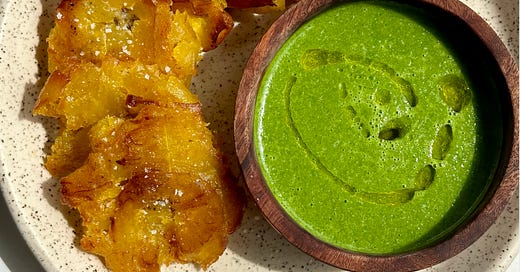


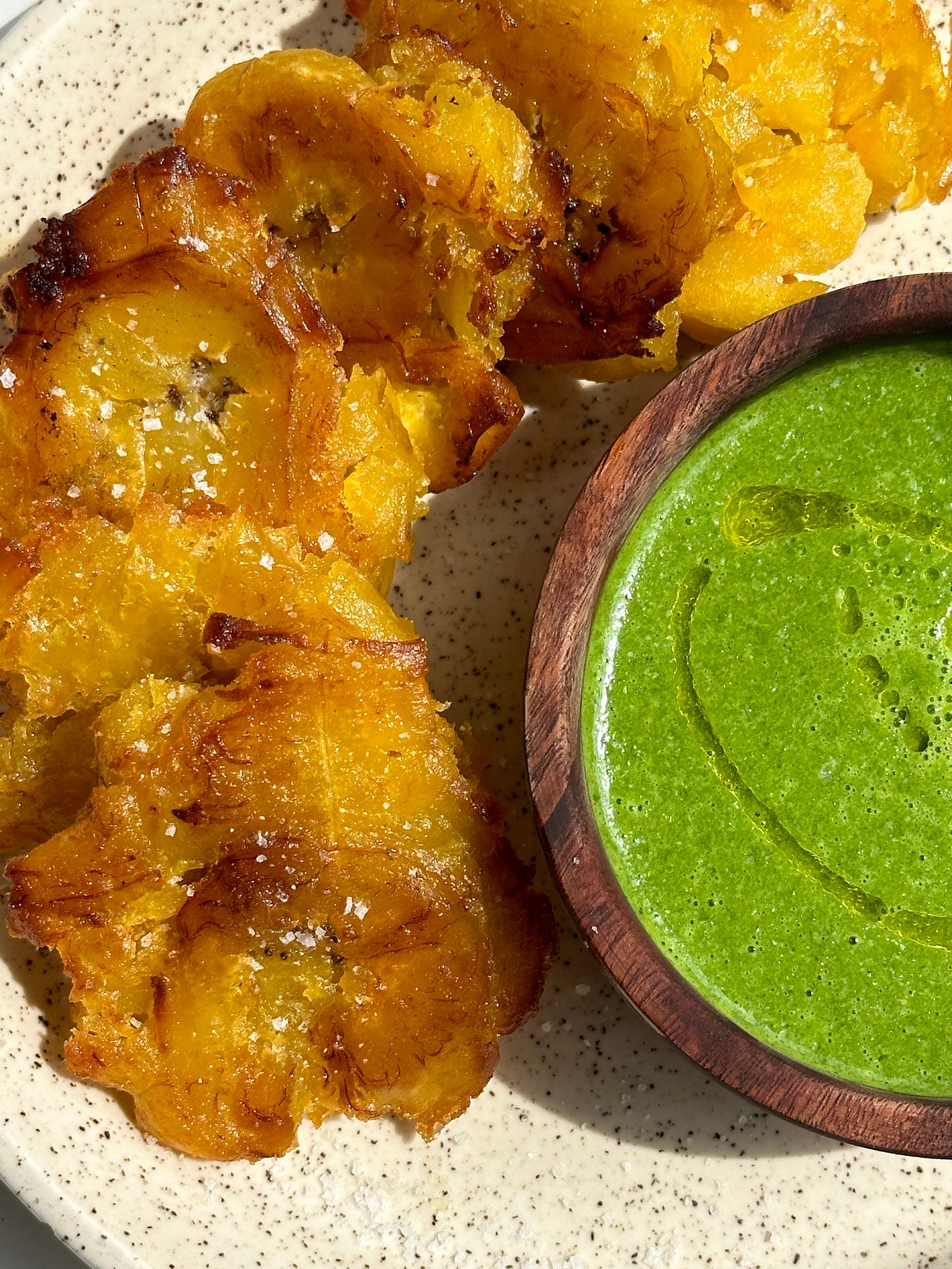

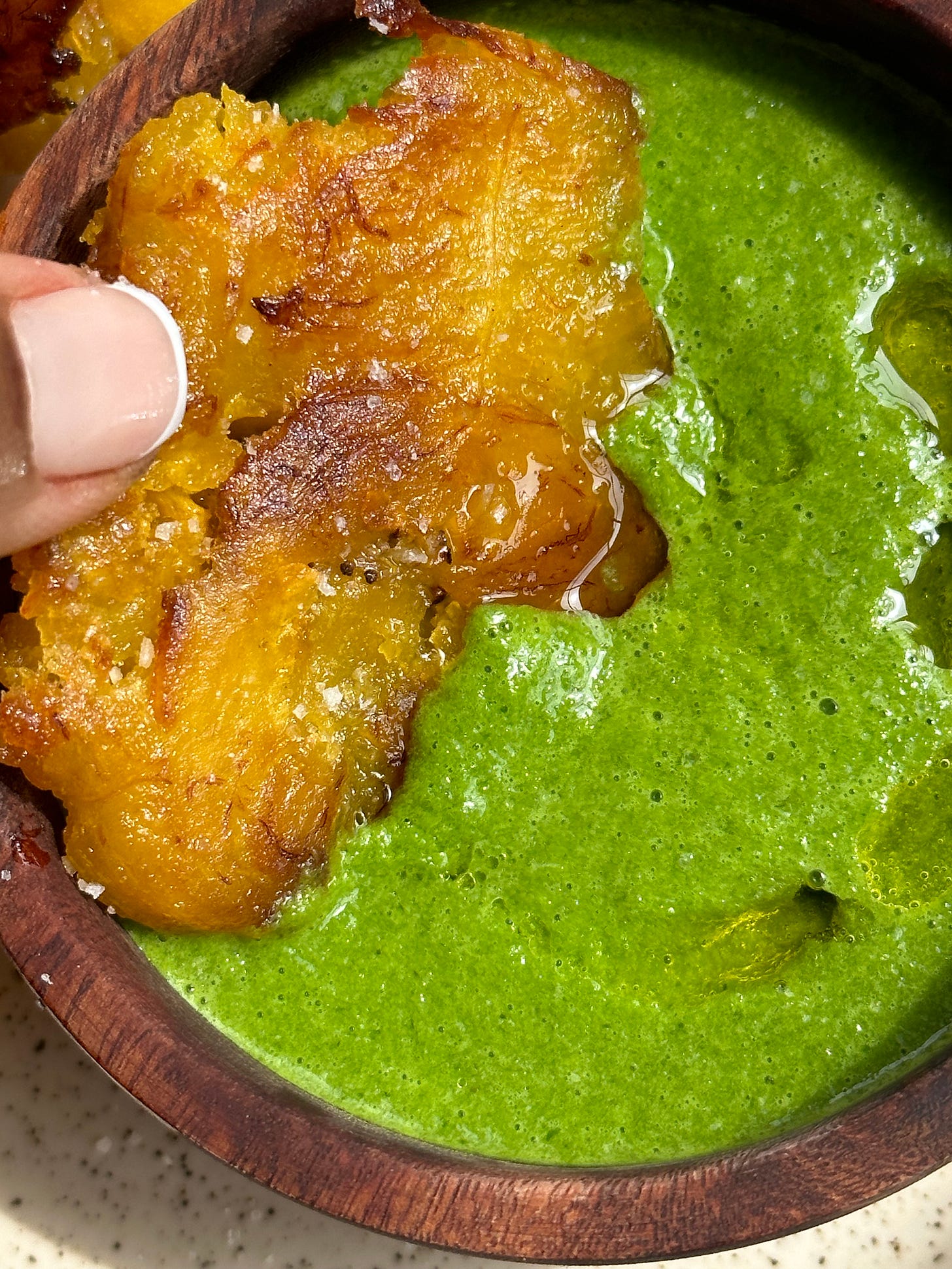
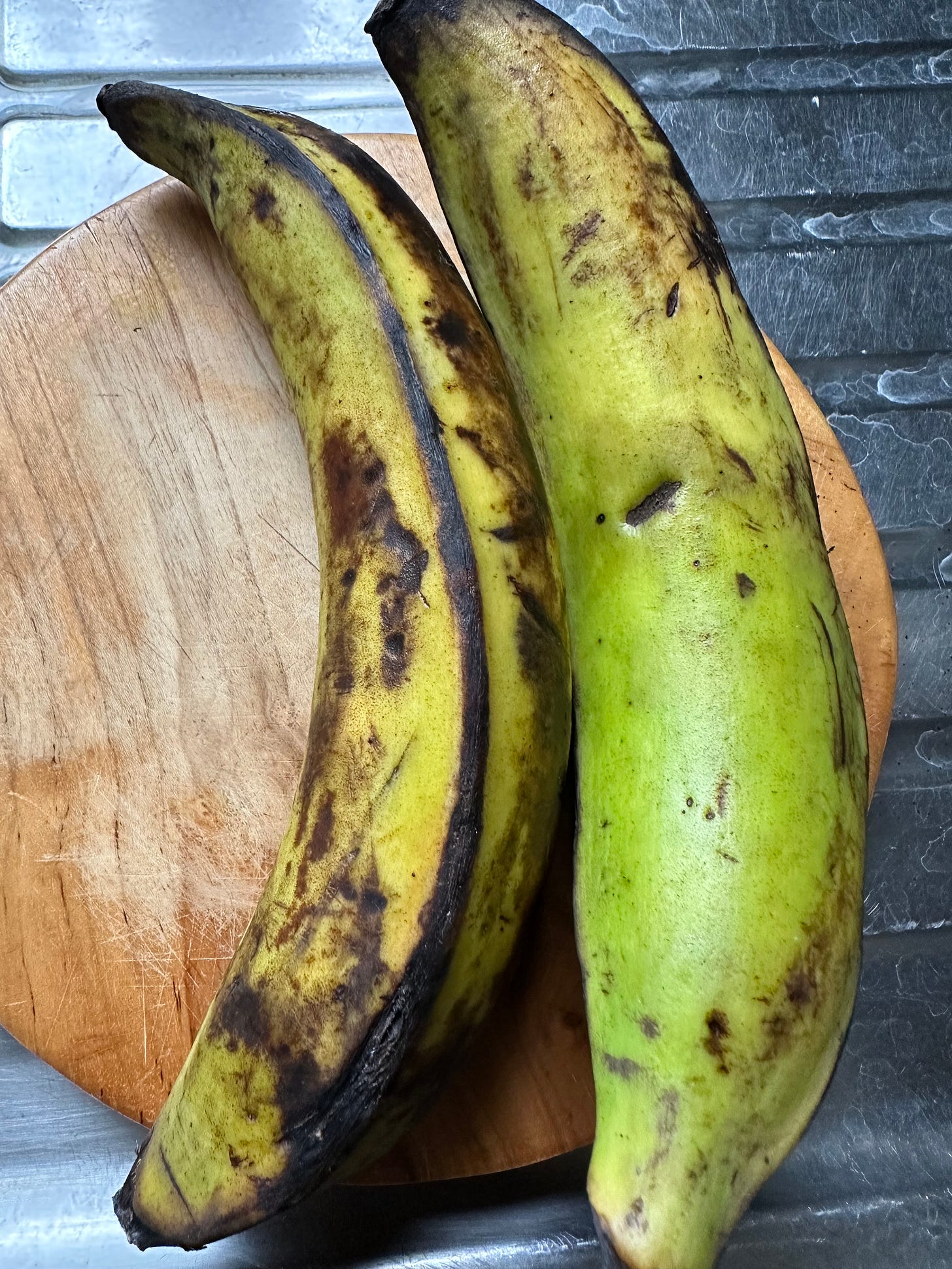
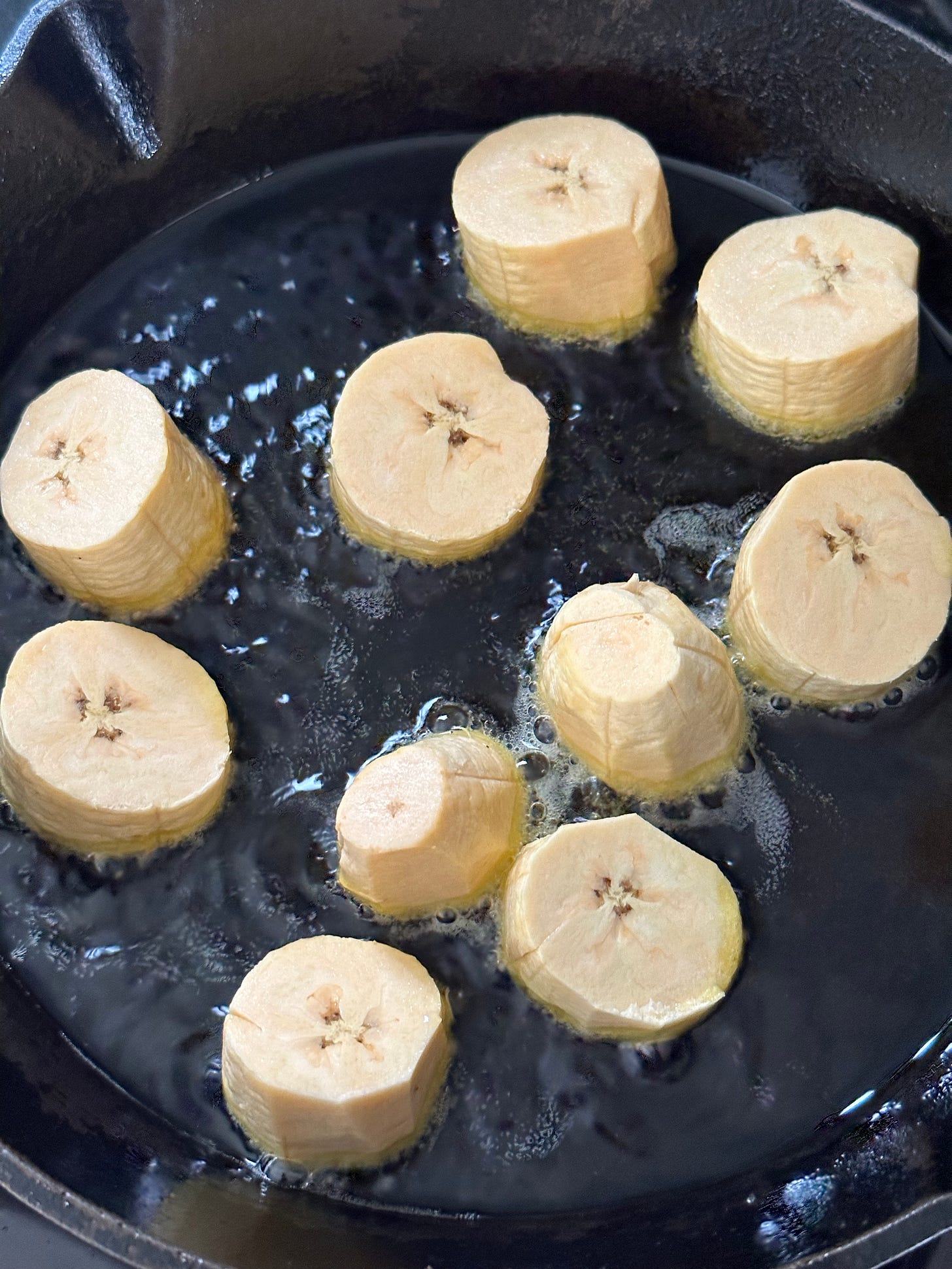
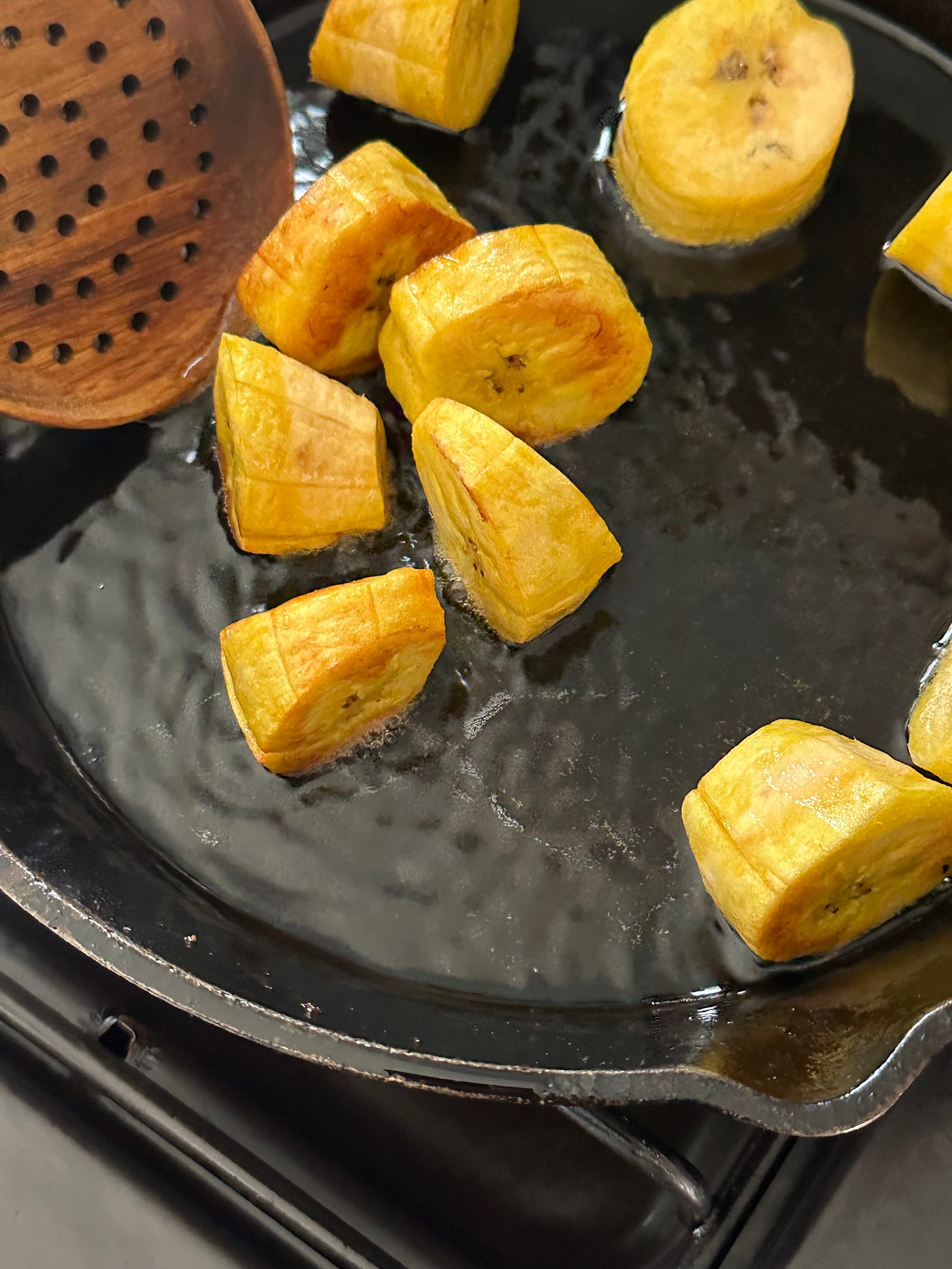
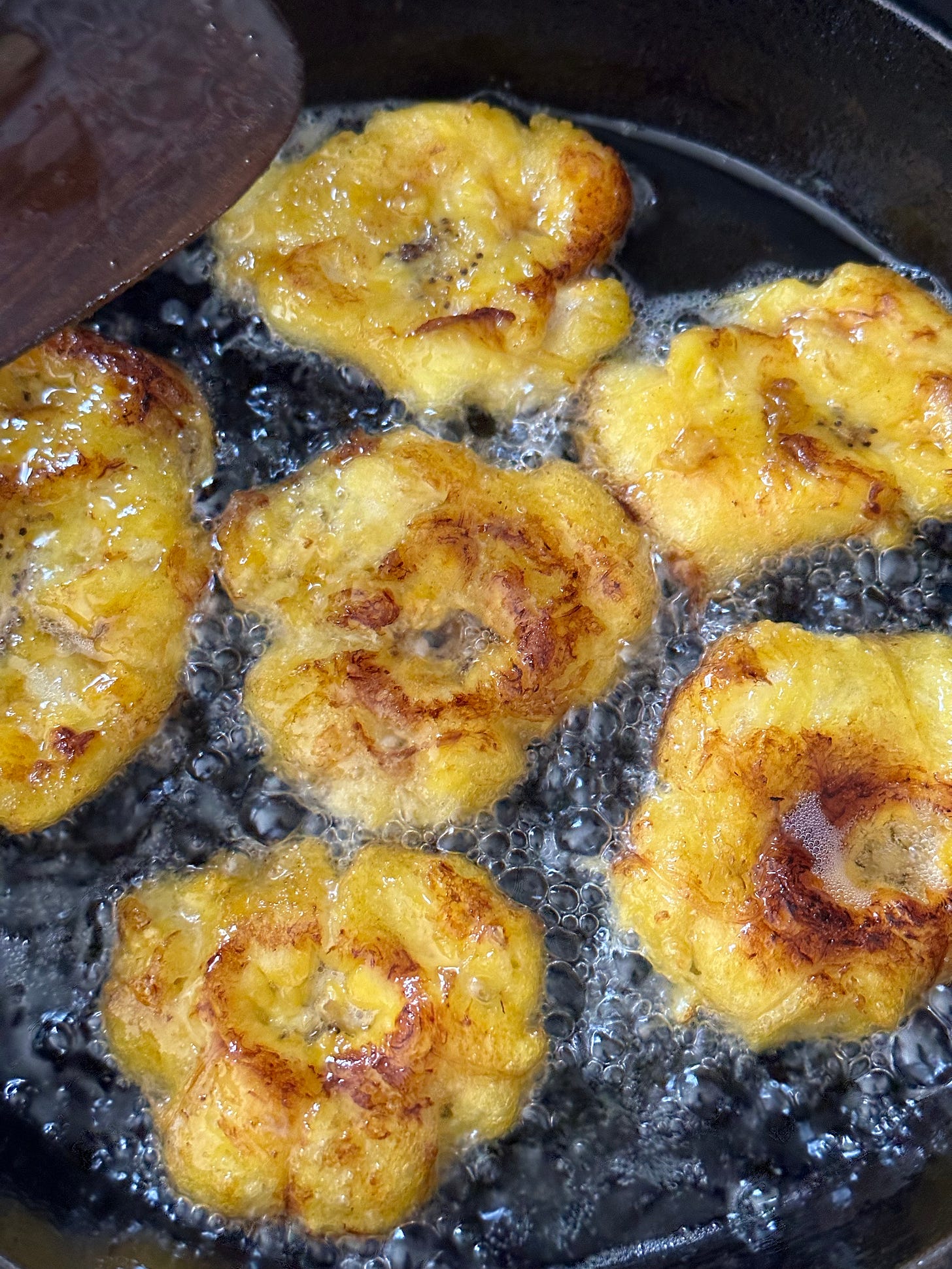
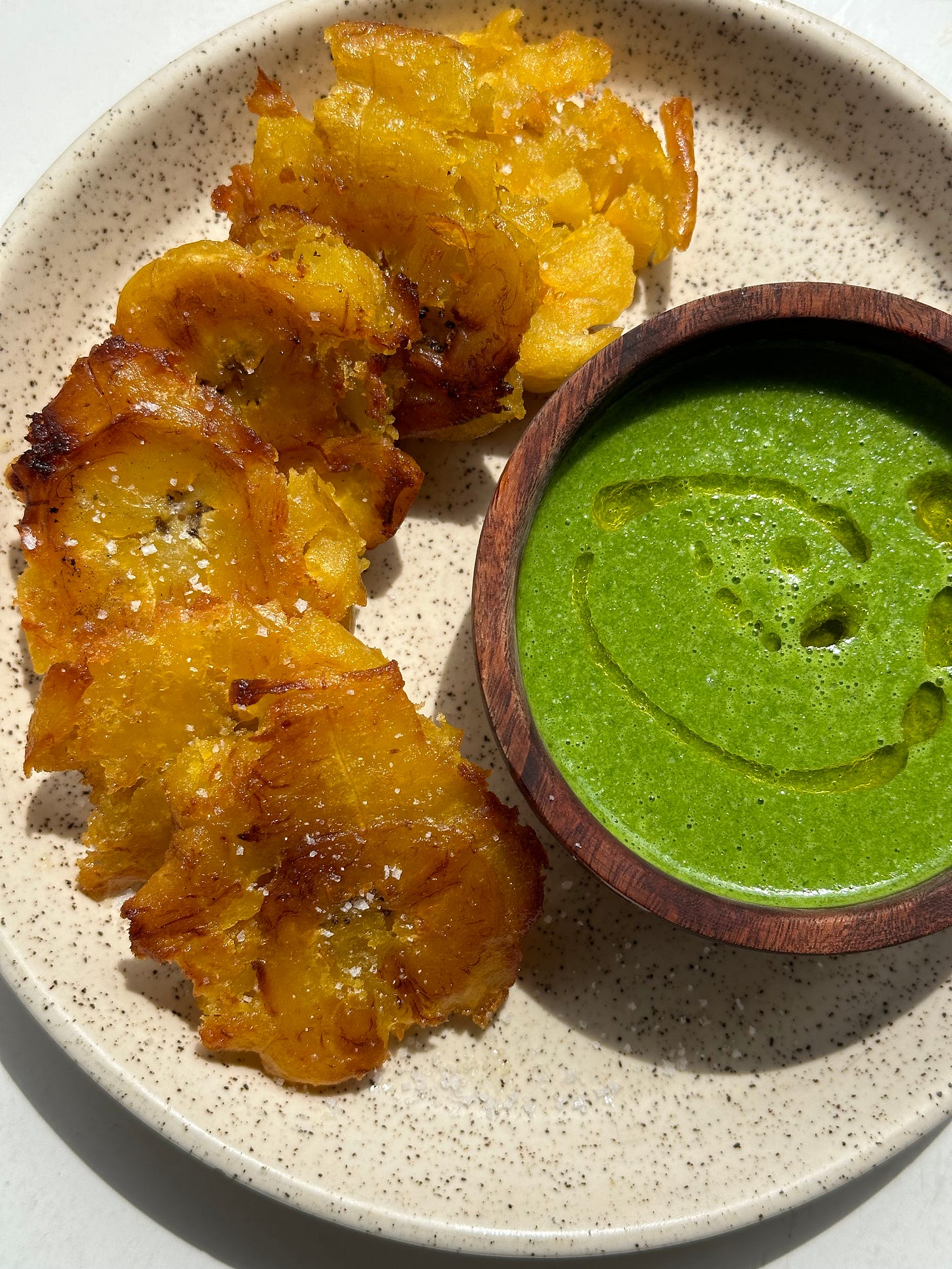
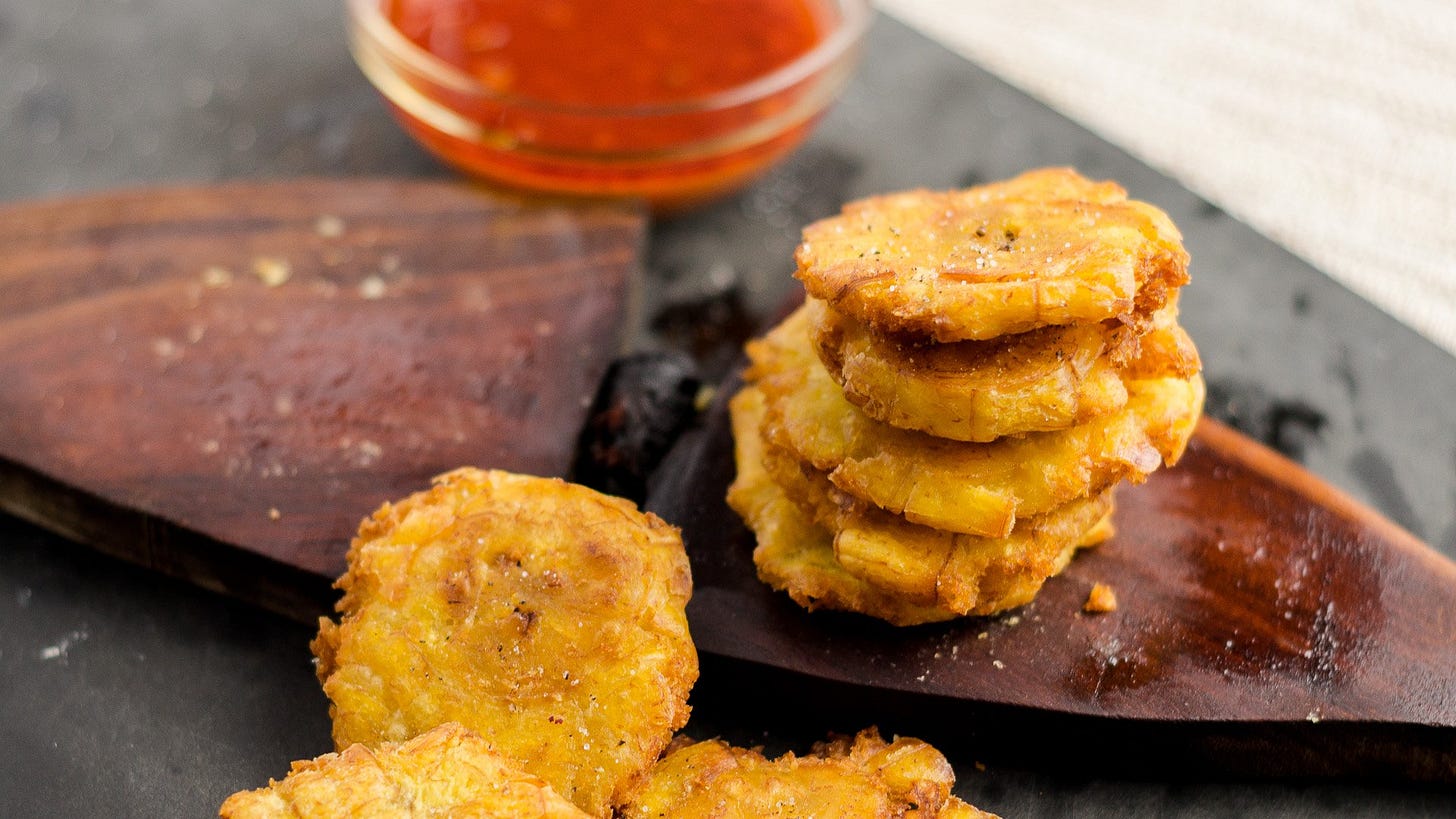
You’ve made me hungry for banann! Love
Me banann, it’s also really great for your gut btw.
Damn, Gina. Now I’m hungry.